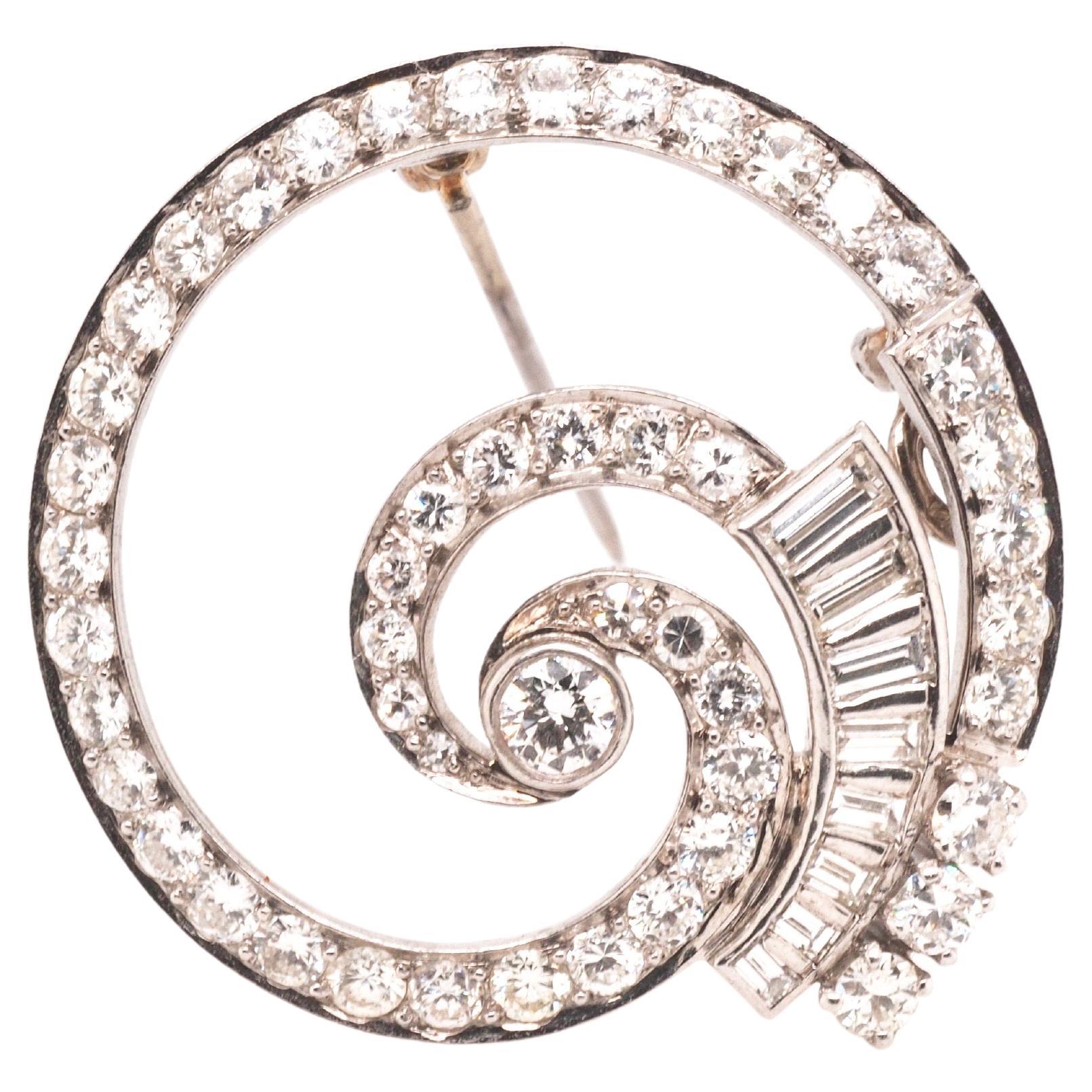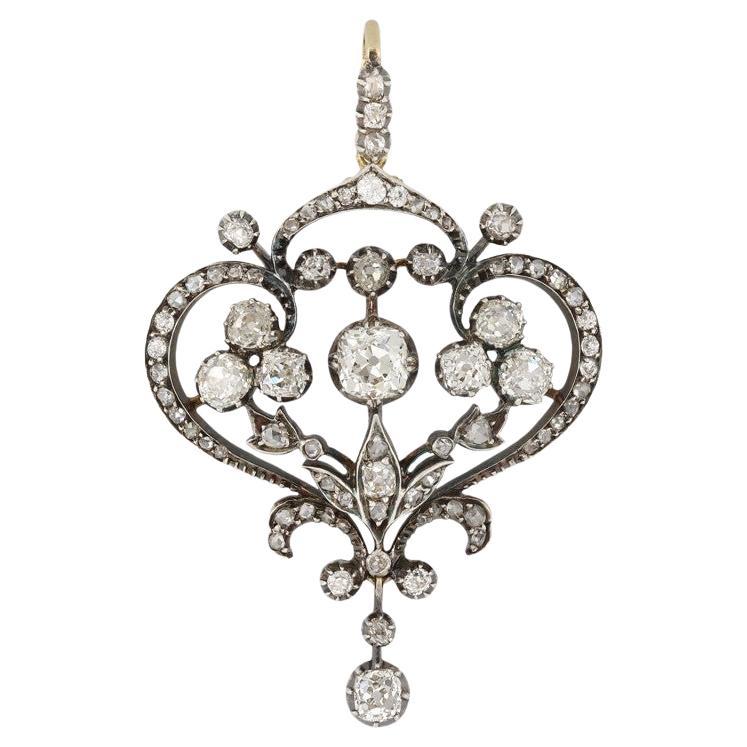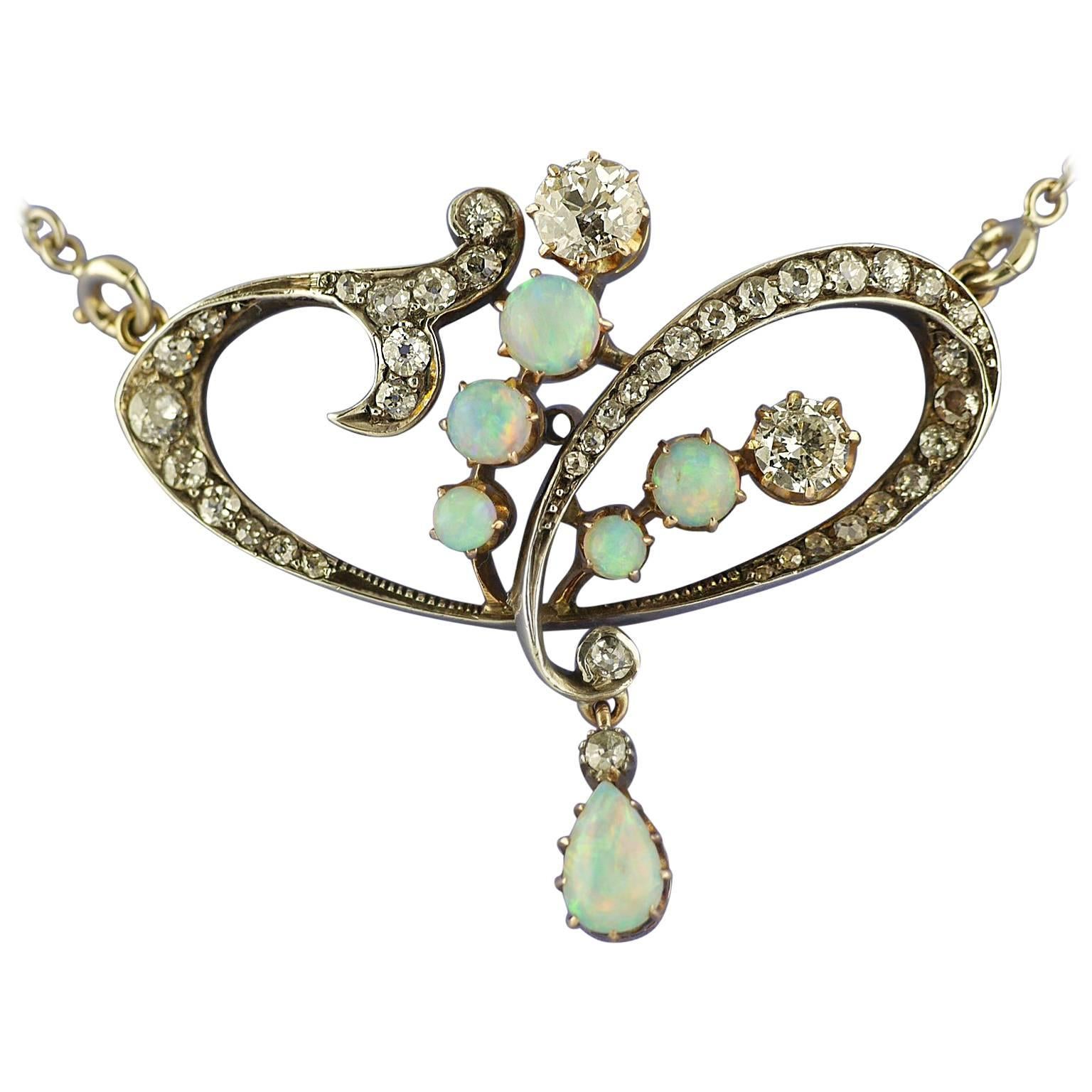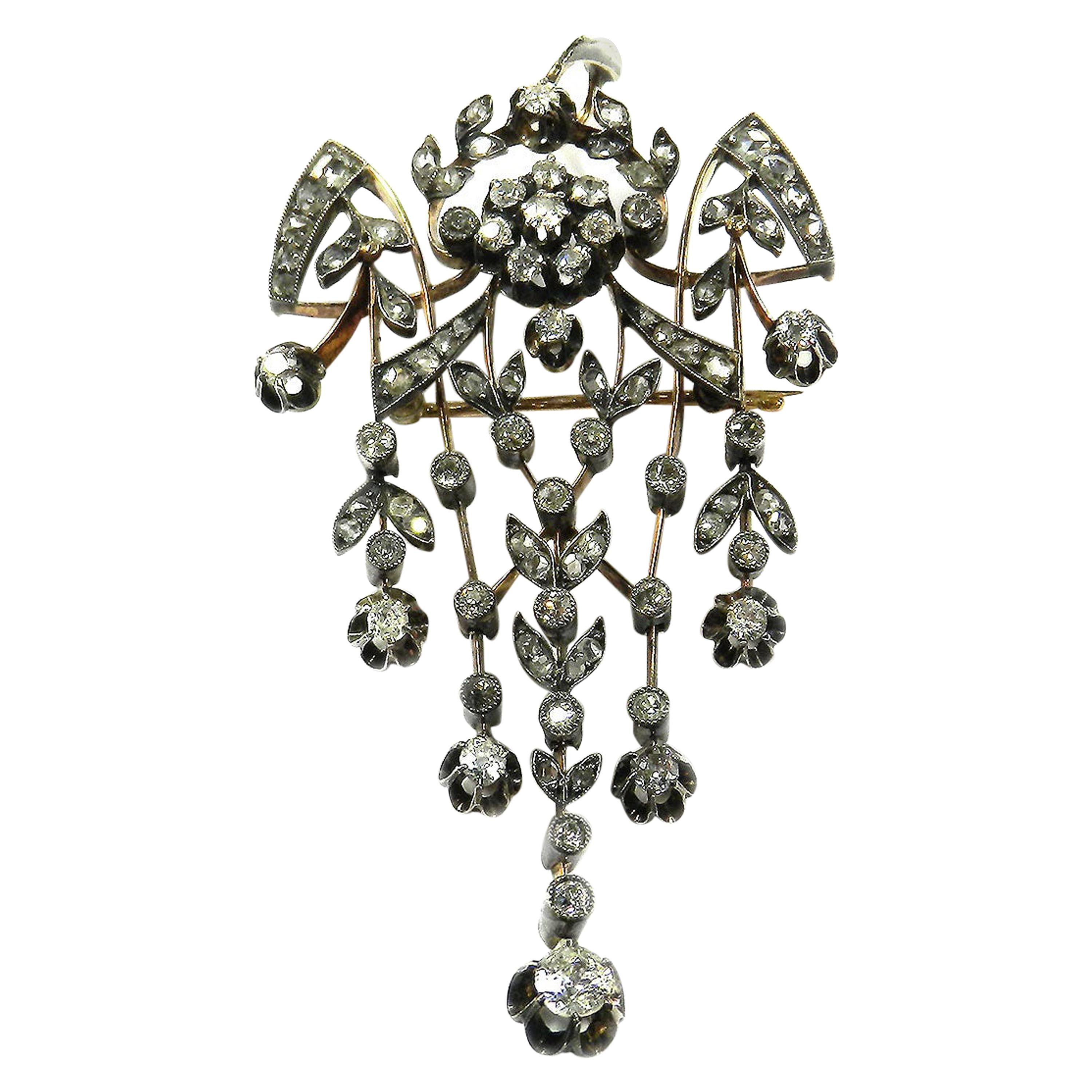Items Similar to Diamond Pendant / Brooch, Circa 1940s
Video Loading
Want more images or videos?
Request additional images or videos from the seller
1 of 7
Diamond Pendant / Brooch, Circa 1940s
About the Item
Ornate, exuberant goldsmithing showcases about 1.20 carats of 42 glittering antique rose-cut diamonds and approximately .85 carats of Old European cut stones in this magnificent, baroque-revival pendant /brooch from around 1940. The total diamond weight is estimated to be just over 2 carats.
The buttery and sturdy 14K yellow gold has been intricately worked by a master goldsmith to create an ornate central pierced foliate design surrounded by an outwardly-curved tri-scalloped brim that has been etched and beaded by hand and set with the 42 stones.
Entirely crafted by hand, the reverse side of the brooch / pendant reveals just how finely crafted this piece truly is. The components -an oval bail that folds out of the way when the piece is in use as a brooch and the original stick pin- are beautifully, and carefully executed and this exceptional quality is the reason why this piece is perfectly wearable today.
I love how the .50 carat diamond and the .15 sparkler above it both swing freely from the body of the piece. The jewel measures 28 x 28mm. The diamonds are white and eye-clean.
There is no maker's mark that I could find. It is marked for 14K. Unisex, unique and brilliant.
- Metal:
- Stone:
- Stone Cut:
- Weight:9.91 g
- Dimensions:Diameter: 1.11 in (28 mm)
- Style:
- Place of Origin:
- Period:
- Date of Manufacture:circa 1940s
- Condition:
- Seller Location:Southbury, CT
- Reference Number:1stDibs: LU1589115924112
About the Seller
5.0
Recognized Seller
These prestigious sellers are industry leaders and represent the highest echelon for item quality and design.
Established in 2011
1stDibs seller since 2019
551 sales on 1stDibs
Typical response time: 3 hours
- ShippingRetrieving quote...Ships From: Southbury, CT
- Return PolicyA return for this item may be initiated within 3 days of delivery.
More From This SellerView All
- Brooch Natural River Pearls, Circa 1940s-1950sLocated in Southbury, CTWhimsical and elegant, this highly detailed brooch was skilfully, artistically created entirely by hand in the middle of the previous century (circa 1940s-1950s). Crafted in 18K yell...Category
Mid-20th Century Unknown Retro Brooches
MaterialsDiamond, Pearl
- Opal Pendant with Chain, Boulder Opal, Circa 1940sLocated in Southbury, CTThis large Retro-era (circa 1940s) boulder opal and 14K yellow and white gold pendant was entirely hand crafted by a master jeweler to suggest an acorn and is a one-of-a-kind treasur...Category
Vintage 1940s North American Retro Pendant Necklaces
MaterialsOpal, 14k Gold
- Fine Highly Translucent Carved Nephrite Pendant & BroochLocated in Southbury, CTUncommonly translucent nephrite jade with exceptionally fine coloring has been skilfully carved into the form of an expressive dragon contained wi...Category
Mid-20th Century Unknown Artisan Pendant Necklaces
MaterialsJade
- Zircon Pendant circa 1940s Original Box 4 Carats PristineLocated in Southbury, CTThis natural earth-mined zircon gem pendant was created from sumptuous yellow gold in the 1940s. And I must tell you, it looks like it has existed within a time capsule since the day...Category
Vintage 1940s North American Retro Drop Necklaces
MaterialsZircon, 14k Gold
- GIA-Certified Diamond & Mother of Pearl Pendant, GeorgianLocated in Southbury, CTDating from around the 1830s, this magnificent Georgian pendant features a silver-over-gold "bow" set with 13 beautiful old rose-cut diamonds that total at least 1 carat. From this s...Category
Antique 1820s Unknown Georgian Pendant Necklaces
MaterialsDiamond, Pearl, Silver
- Fire Opal Ring Certified 5.5 Carats Circa 1940sLocated in Southbury, CTA spectacular and utterly unique 14K yellow gold ring from the Retro era (circa 1940s) featuring six cabochons of natural fire opals from Mexico. These gorgeous and highly-prized gems measure from 9.2mm x 6.7mm to 8.8mm x 6mm. They display orange, orange-yellow sand orange-pink coloring. The dazzling gems weigh approximately 5.5 carats. The face of the ring measures 30mm x 28mm, so it's an impressive and bold ring. The interior is marked for 14K gold but there is no maker's mark. Yet the production quality is extraordinary. The gold metalwork is expertly executed and very whimsical and creative. This bold, flashy, and fun ring is a size 7 and you're jeweler could resize it for you. This ring ships with a certificate from Stone Group Labs stating that these are precious fire opals...Category
Vintage 1940s Retro Cocktail Rings
MaterialsOpal, Fire Opal, 14k Gold
You May Also Like
- Circa 1940s Platinum Art Deco Diamond Circular Swirl Brooch and PendantLocated in Atlanta, GAYear: 1940s Item Details: Metal Type: Platinum with 14K White gold Pin/Clasp [Hallmarked, and Tested] Weight: 7.9 grams *Swivel to convert brooch into a pendant as well Diamond Detai...Category
Vintage 1940s Art Deco Pendant Necklaces
MaterialsDiamond, White Gold, Platinum, 14k Gold
- Victorian diamond pendant/brooch, circa 1880.Located in London, GBVictorian diamond pendant/brooch. Centrally set with a cushion shape old mine diamond in an open back cut-down setting with an approximate we...Category
Antique 1880s Pendant Necklaces
MaterialsDiamond, Yellow Gold, Silver
- Diamond Burst Brooch PendantLocated in Mount Kisco, NYBoth faceted round and marquise shaped diamonds impact the fine design of this vintage piece. Twenty four fine white H/VS diamonds with a total weight of .84 carats create the burst ...Category
Vintage 1950s American Brooches
MaterialsDiamond, White Gold, 14k Gold
- Art Nouveau Diamond Opal Pendant/Brooch, circa 1900Located in London, GB18ct gold & silver set Art Nouveau Diamond Opal Pendant/Brooch dated circa 1900 Five round opals with an articulated pear shaped opal drop, very well matched with lively play of colours and iridescence in reds, greens, blues and gold. Set in 18 carat yellow gold claw collets Two main transitional cut (old mine) diamonds 0.70ct. Mix of old mine and rose cut diamonds in an 18 carat yellow gold with “silver Set” channel setting , approx 1 ct total. G/H/I, VS2-SI2. Total diamond weight: approx 1.7carats Setting diamonds in gold with a thin layer of silver, “silver set”, was a technique used in the Georgian/Victorian/Art Nouveau period as white coloured gold and platinum were not yet available. A very thin layer of silver was applied to the gold, on which the diamonds were set, to show them off to their best advantage (as the yellow would reflect and distort the white colour of the diamonds). The Art Nouveau period was a short lived but worldwide movement which reached its peak at the end of the 19th Century and the first decade of the 20th Century. It had its roots in the Pre Raphaelite and Arts and Crafts movements in Britain in the 1860’s. Artists, such as William Morris, took their inspiration from the flora and fauna of nature and rejected the mass industrialisation and mechanisation of the Victorian age. Art Nouveau continued with this theme and has a distinctive appearance with soft, curved shapes and lines and often depicted natural designs such as flowers, birds and the female form. Before the Art Nouveau period, the emphasis had been to design pieces with an emphasis on gem stones, diamonds, rubies emeralds etc. However, during the Art Nouveau period, jewellers adopted the idea of using other semi–precious stones “from nature” such as agate, garnet opal, moonstone, aquamarine and experimented with a wide variety of new techniques e.g. enamelling. The “New Art” style became a worldwide movement encompassing all disciplines of the arts, and world class artists as far afield as Gaudi with his “modernisme” architecture in Spain, Louis Comfort Tiffany in New York with objects, Galle Glass in France and the Liberty & Co Archibald Knox designs in Britain, Jugendstil in Northern Europe and Faberge in Russia. The movement flared brightly but briefly and by 1910 it was already going out of style to be replaced by Art Deco. In fitted period box. Detachable 18ct brooch...Category
Antique Early 1900s British Art Nouveau Pendant Necklaces
MaterialsWhite Diamond, Opal, Diamond, 18k Gold, Yellow Gold, Silver
- Art Nouveau Diamond Opal Pendant/Brooch, circa 1900Located in London, GB18ct gold & silver set Art Nouveau Diamond Opal Pendant/Brooch dated circa 1900 Five round opals with an articulated pear shaped opal drop, very well matched with lively play of colours and iridescence in reds, greens, blues and gold. Set in 18 carat yellow gold claw collets Two main transitional cut (old mine) diamonds 0.70ct. Mix of old mine and rose cut diamonds in an 18 carat yellow gold with “silver Set” channel setting , approx 1 ct total. G/H/I, VS2-SI2. Total diamond weight: approx 1.7carats Setting diamonds in gold with a thin layer of silver, “silver set”, was a technique used in the Georgian/Victorian/Art Nouveau period as white coloured gold and platinum were not yet available. A very thin layer of silver was applied to the gold, on which the diamonds were set, to show them off to their best advantage (as the yellow would reflect and distort the white colour of the diamonds). The Art Nouveau period was a short lived but worldwide movement which reached its peak at the end of the 19th Century and the first decade of the 20th Century. It had its roots in the Pre Raphaelite and Arts and Crafts movements in Britain in the 1860’s. Artists, such as William Morris, took their inspiration from the flora and fauna of nature and rejected the mass industrialisation and mechanisation of the Victorian age. Art Nouveau continued with this theme and has a distinctive appearance with soft, curved shapes and lines and often depicted natural designs such as flowers, birds and the female form. Before the Art Nouveau period, the emphasis had been to design pieces with an emphasis on gem stones, diamonds, rubies emeralds etc. However, during the Art Nouveau period, jewellers adopted the idea of using other semi–precious stones “from nature” such as agate, garnet opal, moonstone, aquamarine and experimented with a wide variety of new techniques e.g. enamelling. The “New Art” style became a worldwide movement encompassing all disciplines of the arts, and world class artists as far afield as Gaudi with his “modernisme” architecture in Spain, Louis Comfort Tiffany in New York with objects, Galle Glass in France and the Liberty & Co Archibald Knox designs in Britain, Jugendstil in Northern Europe and Faberge in Russia. The movement flared brightly but briefly and by 1910 it was already going out of style to be replaced by Art Deco. Detachable 18ct brooch...Category
Antique Early 1900s British Art Nouveau Pendant Necklaces
MaterialsDiamond, White Diamond, Opal, 18k Gold, Yellow Gold, Silver
- Antique 2.5 Carat Diamond Gold Pendant Brooch Moscow circa 1910Located in Goettingen, DEAntique 2.5 carat diamond Gold Pendant Brooch “Devant de Corsage” Moscow circa 1910 This decorative, openwork brooch can als o be worn as a pendant, featuirng a central rosette, ga...Category
Antique Early 1900s Russian Russian Empire Brooches
MaterialsDiamond, Gold, 14k Gold, Silver
Recently Viewed
View AllMore Ways To Browse
50 Carat Diamond
Gold Diamond Jewelry 1940s
1940s 14k
1940s Diamond Set
Love Brooch
Vintage Brooches 1940S
Vintage Hand Brooch
Diamond Brooch Pendant Pin
Antique Brooch Pendants
Vintage Eye Brooch
Vintage Brooch Makers
Oval Diamond Brooch
Old Vintage Brooches
Old European Cut Oval Diamond
1940s Gold Brooch
Etched Diamond
Antique Diamond Pendant Brooch
Antique Gold Diamond Brooch Pendants





